The ASRock E3V5 Performance Gaming (C232) Motherboard Review
by Ian Cutress on May 4, 2016 9:00 AM EST- Posted in
- Motherboards
- ASRock
- Xeon
- Skylake
- Intel C232
CPU Performance, Short Form
For our motherboard reviews, we use our short form testing method. These tests usually focus on if a motherboard is using MultiCore Turbo (the feature used to have maximum turbo on at all times, giving a frequency advantage), or if there are slight gains to be had from tweaking the firmware. We leave the BIOS settings at default and memory at JEDEC (DDR4-2133 C15) for these tests, making it very easy to see which motherboards have MCT enabled by default.
Video Conversion – Handbrake v0.9.9: link
Handbrake is a media conversion tool that was initially designed to help DVD ISOs and Video CDs into more common video formats. For HandBrake, we take two videos (a 2h20 640x266 DVD rip and a 10min double UHD 3840x4320 animation short) and convert them to x264 format in an MP4 container. Results are given in terms of the frames per second processed, and HandBrake uses as many threads as possible.
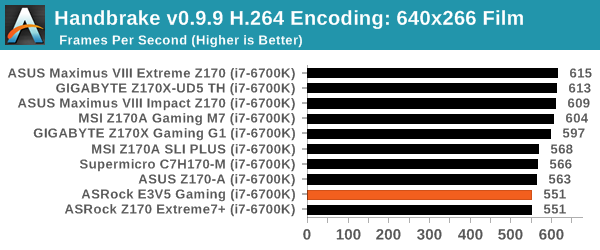
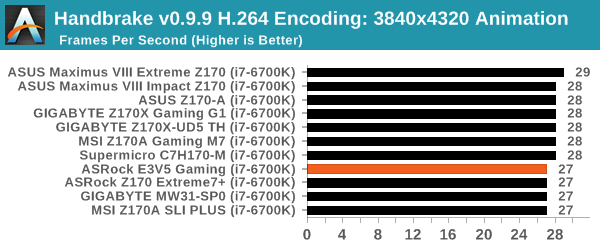
Compression – WinRAR 5.0.1: link
Our WinRAR test from 2013 is updated to the latest version of WinRAR at the start of 2014. We compress a set of 2867 files across 320 folders totaling 1.52 GB in size – 95% of these files are small typical website files, and the rest (90% of the size) are small 30 second 720p videos.
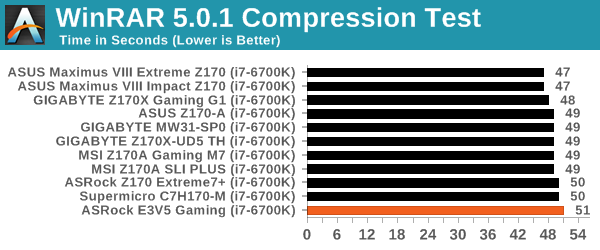
Point Calculations – 3D Movement Algorithm Test: link
3DPM is a self-penned benchmark, taking basic 3D movement algorithms used in Brownian Motion simulations and testing them for speed. High floating point performance, MHz and IPC wins in the single thread version, whereas the multithread version has to handle the threads and loves more cores. For a brief explanation of the platform agnostic coding behind this benchmark, see my forum post here.
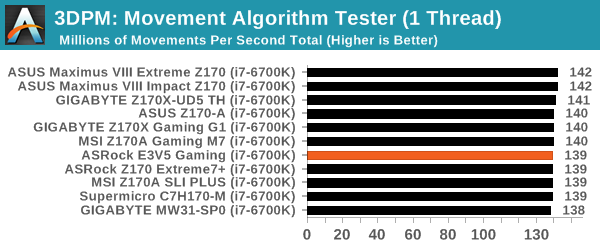

Rendering – POV-Ray 3.7: link
The Persistence of Vision Ray Tracer, or POV-Ray, is a freeware package for as the name suggests, ray tracing. It is a pure renderer, rather than modeling software, but the latest beta version contains a handy benchmark for stressing all processing threads on a platform. We have been using this test in motherboard reviews to test memory stability at various CPU speeds to good effect – if it passes the test, the IMC in the CPU is stable for a given CPU speed. As a CPU test, it runs for approximately 2-3 minutes on high-end platforms.
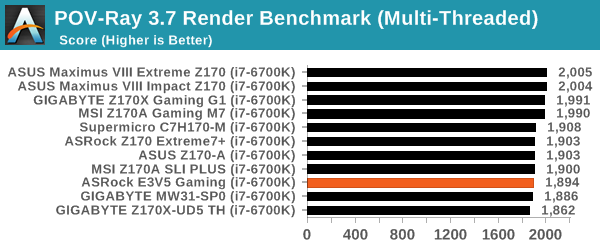
Synthetic – 7-Zip 9.2: link
As an open source compression tool, 7-Zip is a popular tool for making sets of files easier to handle and transfer. The software offers up its own benchmark, to which we report the result.
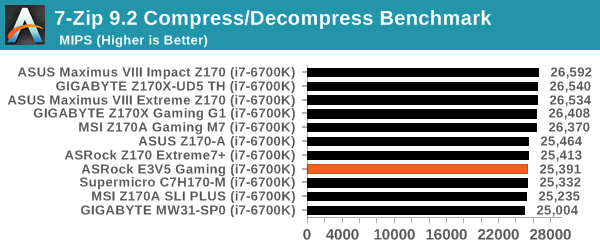










22 Comments
View All Comments
DanNeely - Wednesday, May 4, 2016 - link
The USB 2/3 information in the table on the first page doesn't appear consistent between C236/C232 and Q170/B150. Is it correct? eg the latter lists 10/14 USB3/2 ports reflecting support for 14 USB ports, of which up to 10 can be converted into USB3 ports by combining them with a high speed IO lane from the chipset. The C236 lists 10/4 ports; which is the distribution you'd get if using 10 HSIO lanes to make the max number of USB3 ports. However putting it in the table like that implies that the 10 lanes are locked into USB3; which strikes me as odd, since for server/workstation uses SATA/PCIe/m.2 seem like they'd be more generally useful than lots of USB3.close - Wednesday, May 4, 2016 - link
Apparently you can slap "performance-gaming" even on a product based on a cut down B150 with Xeon support. This is one way to devalue this kind of branding.BurntMyBacon - Wednesday, May 4, 2016 - link
@close: "Apparently you can slap "performance-gaming" even on a product based on a cut down B150 with Xeon support. This is one way to devalue this kind of branding."The mentality is a little different than that. They think you can slap "performance-gaming" on anything with overclocking features. Putting aside the fact that these are two different markets, they had the unfortunate lack of foresight to predict that Intel would shut the new fangled Xeon overclocking features down. Now the board no longer fits even their definition of "performance-gaming", but their is no way for the average consumer to know that. They should have rebranded the product. Instead, they've done exactly as you said, devalued the branding.
close - Wednesday, May 4, 2016 - link
To be honest I only spotted the "OC" part after I posted the comment. Waiting for the "Gaming-Performance-OC-Megatron stick in the mud" edition.xKrNMBoYx - Monday, May 9, 2016 - link
Actually I have this motherboard and a E3 1275 V5. You can still OC on the very first BIOS (v1) or on the beta BIOS 1.3. Enjoying a 4.5GHz Skylake Xeon.Zarok001 - Wednesday, December 28, 2016 - link
Can I still download this bios anywhere. I was told that this overclocking still works and now im sitting here with a GTX 1070 and a locked Intel Xeon E3-1245v5, i mean it boosts up to 3.9Ghz but i would love to overclock it.BrokenCrayons - Thursday, May 5, 2016 - link
Let's face it, the branding doesn't have much value anyway at this point regardless of what ASRock does to it. It's silly to stick numbers into words these days as is done with the 1 in the word Fatal1ty. That just comes off as 1990's era childish. "Performance-gaming" is just marketing speak that is intended to appeal to a targeted audience of potential buyers in order to enable an exchange of money and products. The same is true of the color scheme the vendor selected, some of the "features" of the motherboard itself, and licensing the use of a now unknown crusty old "pro gamer." In order to charge a price premium, companies have to ensure their products fit the buyer both in actual capabilities, perceived benefits, and emotional appeal. It's pretty safe to dismiss the majority of ASRock's marketing materials (and probably for the best in all product purchases in order to make a rational decision) so a potential buyer can assess the actual benefits the product offers.And yes, I've been accused of being a buzzkill more than once. :)
Gunbuster - Wednesday, May 4, 2016 - link
So this is the weird byproduct of Xeon overclocking being discovered? But since Intel slapped down all the board manufacturers this is now an effectively useless product?jasonelmore - Wednesday, May 4, 2016 - link
Intel just doesnt wanna sell the new gen CPU's with OC and ECC..tons of people wanna build a skylake nas box with ECC for freenas, but intel is making it very hard to do this without buying a integrated board with a bunch of atom cores. We want the OC for VM performance, while still keeping ECC
StrangerGuy - Thursday, May 5, 2016 - link
I for one, is still amazed that people expects overclocking free lunches from Intel in year 2016 like they are still living in 2007.